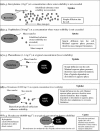Monitoring of microbial hydrocarbon remediation in the soil
- PMID: 22611524
- PMCID: PMC3339601
- DOI: 10.1007/s13205-011-0014-8
Monitoring of microbial hydrocarbon remediation in the soil
Abstract
Bioremediation of hydrocarbon pollutants is advantageous owing to the cost-effectiveness of the technology and the ubiquity of hydrocarbon-degrading microorganisms in the soil. Soil microbial diversity is affected by hydrocarbon perturbation, thus selective enrichment of hydrocarbon utilizers occurs. Hydrocarbons interact with the soil matrix and soil microorganisms determining the fate of the contaminants relative to their chemical nature and microbial degradative capabilities, respectively. Provided the polluted soil has requisite values for environmental factors that influence microbial activities and there are no inhibitors of microbial metabolism, there is a good chance that there will be a viable and active population of hydrocarbon-utilizing microorganisms in the soil. Microbial methods for monitoring bioremediation of hydrocarbons include chemical, biochemical and microbiological molecular indices that measure rates of microbial activities to show that in the end the target goal of pollutant reduction to a safe and permissible level has been achieved. Enumeration and characterization of hydrocarbon degraders, use of micro titer plate-based most probable number technique, community level physiological profiling, phospholipid fatty acid analysis, 16S rRNA- and other nucleic acid-based molecular fingerprinting techniques, metagenomics, microarray analysis, respirometry and gas chromatography are some of the methods employed in bio-monitoring of hydrocarbon remediation as presented in this review.
Figures






References
-
- Abu GO, Chikere BO. Cell surface properties of hydrocarbon-utilizing bacterial isolates from Port Harcourt marine environment. Nig J Microbiol. 2006;20:809–816.
-
- Adoki A, Orugbani T. Removal of crude petroleum hydrocarbons by heterotrophic bacteria in soils amended with nitrogenous fertilizer plant effluents. Afr J Biotech. 2007;6:1529–1535.
-
- Alexander M. Biodegradation and bioremediation. 2. San Diego: Academic Press; 1999.
-
- Allen JP, Atekwana EA, Duris JW, Werkema DD, Rossbach S. The microbial community structure in petroleum-contaminated sediments corresponds to geophysical signatures. Appl Environ Microbiol. 2007;73:2860–2870.
LinkOut - more resources
Full Text Sources
Other Literature Sources

